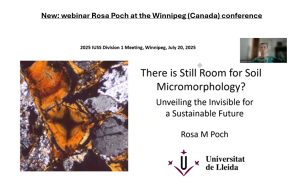This section aims to elaborate ideas, initiatives and any additional info on soil micromorphology applied to paleopedology (and geomorphology). This section is led by Fabio Scarciglia (University Calabria, Italy). For any contribution, please write to scarciglia@unical.it.
Basic information :
Soil micromorphology and soil microscopy serve as invaluable tools in the fields of paleopedology and geomorphology, offering detailed insights into the formation processes of soils and landforms over geological time scales. Through the microscopic examination of soil thin sections and microstructures, researchers can unravel the intricate histories of landscapes, decipher environmental changes, and understand soil development processes.
In paleopedology, soil micromorphology plays a central role in reconstructing past environmental conditions and paleoclimates. By analyzing microscopic features such as pedorelicts, microaggregates, clay, silt, Fe or Mn coatings, paleopedologists can infer past soil-forming processes and environmental parameters. These insights are crucial for interpreting past climates, vegetation patterns, and landscape dynamics, and for reconstructing past ecosystems and biogeochemical cycles.
Moreover, soil micromorphology aids in the identification of paleosols, ancient soil horizons preserved within sedimentary sequences, which provide important records of past landscapes and soil-forming processes. By examining the microstratigraphy of paleosols, researchers can reconstruct sequences of soil development, soil erosion events, and landscape evolution, contributing to our understanding of long-term soil-landscape dynamics.
In geomorphology, soil micromorphology offers valuable insights into the formation and evolution of landscapes. Microscopic analysis of soil sediments helps geomorphologists decipher the depositional history of landforms, including alluvial deposits, colluvial slopes, and aeolian dunes. By examining soil sedimentary microstructures, researchers can reconstruct past sedimentary environments, depositional processes, and sediment provenance, shedding light on the mechanisms driving landscape change.
Furthermore, soil micromorphology provides important evidence for interpreting paleoenvironmental conditions and geomorphic processes, such as soil erosion, weathering, and sediment transport.
In conclusion, soil micromorphology and soil microscopy are essential tools in paleopedology and geomorphology, offering unparalleled insights into the long-term dynamics of soils and landscapes. By delving into the microscopic world of soil sediments, researchers can reconstruct past environmental conditions, decipher landscape evolution processes, and understand the complex interactions between geology, climate, and biology that shape our planet over geological time scales.

